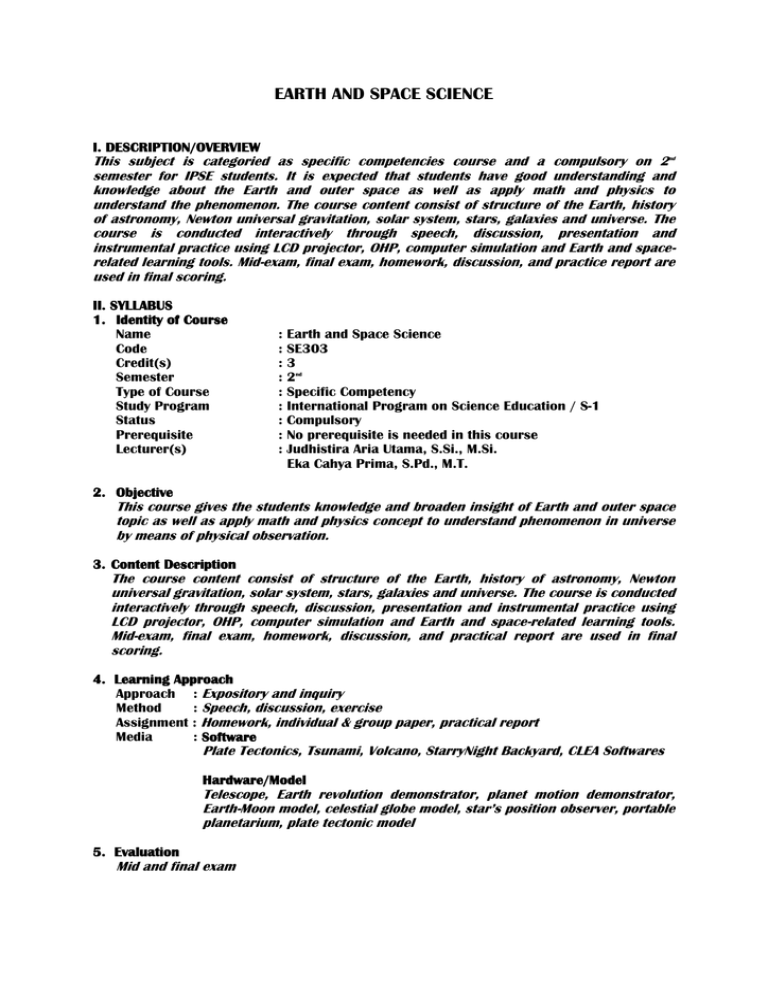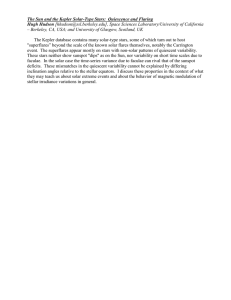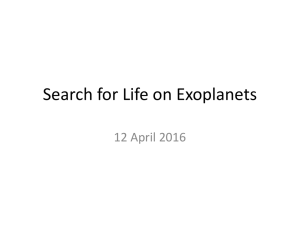
EARTH AND SPACE SCIENCE
I. DESCRIPTION/OVERVIEW
This subject is categoried as specific competencies course and a compulsory on 2nd
semester for IPSE students. It is expected that students have good understanding and
knowledge about the Earth and outer space as well as apply math and physics to
understand the phenomenon. The course content consist of structure of the Earth, history
of astronomy, Newton universal gravitation, solar system, stars, galaxies and universe. The
course is conducted interactively through speech, discussion, presentation and
instrumental practice using LCD projector, OHP, computer simulation and Earth and spacerelated learning tools. Mid-exam, final exam, homework, discussion, and practice report are
used in final scoring.
II. SYLLABUS
1. Identity of Course
Name
Code
Credit(s)
Semester
Type of Course
Study Program
Status
Prerequisite
Lecturer(s)
:
:
:
:
:
:
:
:
:
Earth and Space Science
SE303
3
2nd
Specific Competency
International Program on Science Education / S-1
Compulsory
No prerequisite is needed in this course
Judhistira Aria Utama, S.Si., M.Si.
Eka Cahya Prima, S.Pd., M.T.
2. Objective
This course gives the students knowledge and broaden insight of Earth and outer space
topic as well as apply math and physics concept to understand phenomenon in universe
by means of physical observation.
3. Content Description
The course content consist of structure of the Earth, history of astronomy, Newton
universal gravitation, solar system, stars, galaxies and universe. The course is conducted
interactively through speech, discussion, presentation and instrumental practice using
LCD projector, OHP, computer simulation and Earth and space-related learning tools.
Mid-exam, final exam, homework, discussion, and practical report are used in final
scoring.
4. Learning Approach
Approach : Expository and inquiry
Method
: Speech, discussion, exercise
Assignment : Homework, individual & group paper, practical report
Media
: Software
Plate Tectonics, Tsunami, Volcano, StarryNight Backyard, CLEA Softwares
Hardware/Model
Telescope, Earth revolution demonstrator, planet motion demonstrator,
Earth-Moon model, celestial globe model, star’s position observer, portable
planetarium, plate tectonic model
5. Evaluation
Mid and final exam
6. Meeting Agenda
1st Week
: Introduction: Description and Syllabus
Lithosphere:
Earth’s crust
Weathering
2nd Week
: Magmatism and vulkanism
3rdWeek
: Earthquake
4th Week
: Hydrosphere:
River
Lake
Sea and ocean
5th Week
: Erotion and sedimentation, movement of snow and ice
6th Week
: Atmosphere:
Troposphere
Stratosphere
Ionosphere
Exosphere
7th Week
: Earth Science Project Activity
8th Week
: Mid Exam
9th Week
: Understanding The Sky
The stars: constellations, the name of the stars
The sky and its motion: celestial sphere, coordinate systems
(horizontal, equatorial, ecliptic and sidereal time), daily phenomenon
(twilight, rising and setting)
Models of planetary motion
The seasons
The moving planets: planet configurations, retrograde motion
10th Week
: Universal Gravitation
Newton’s law of universal gravitation: measuring gravitational
constant, free-fall acceleration and the gravitational force
Energy Consideration in Planetary and Satellite Motion: orbital energy
, escape speed
Tidal Force: effects of tidal force
Kepler’s Laws: kepler’s first law, second law and thrid law
11th Week
: Solar System and Extrasolar Planets
Origin of the Solar System: origin of life on earth, life in the rest of
the solar system?
The Sun and Planets: characteristics of the sun, radar mapping of planets, temperature of planets and density of planets
Minor Bodies in the Solar System
Other Planetary Systems: methods and techniques of detection,
searches for extraterrestrial intelligence
12rd Week
: Instrumentation: Optical Telescope
Main Function of Telescope
Types of Telescope and Optical Design
Optical Parameters of Telescope: light-gathering power, magnification,
resolving power, limiting magnitude, image scale, apparent and actual
field of view
13th Week
: Astrophysics
Properties of the Star: stellar apparent magnitude and color, stellar
distance, stellar absolute magnitude, stellar mass-radius-temperature,
stellar spectrum
Hertzsprung–Russell Diagram: luminosity class, hertzsprung-russell
diagram of stellar cluster
14th Week
15th Week
16th Week
Stellar Evolution: energy generation, evolution off the main sequence
(low and high mass stars)
: Galaxy and Cosmology
Types of Galaxy
Milky Way: basic structure and dimension
Big Bang Model: cosmic microwave background, hubble law
: Earth & Space Science Project Activity
: Final exam
7. Reference(s)
For Earth Science topic:
[1] Adams, S. and Lambert, D., 2006, Earth Science: An illustrated guide to science,
Chelsea House Publishers
[2] Tarbuck, E.J., Lutgens, F.K. and Tasa, D., 2009, Earth Science, Pearson Prentice Hall
For Space Science topic:
[1] Karttunen, H., et al., 2007, Fundamental Astronomy 5th Edition, Springer-Verlag, Berlin
Heidelberg
[2] Kutner, M.L., 2003, Astronomy: A Physical Perspective, Cambridge University Press
[3] Roy, A.E., and Clarke, D., 1978, Astronomy: Principles and Practice, Adam Hilger Ltd.,
Bristol
III. LEARNING ACTIVITY UNIT
Course
Code
Credit(s)
Semester
Lecturer(s)
: Earth and Space Science
: SE303
:3
: 2nd
: Agus Fany Chandra Wijaya, S.Pd., M.Pd.
Judhistira Aria Utama, M.Si.
Week
1
Basic Competency
Describe the
elements and
compounds
related to the
composition of
the earth’s crust.
Indicator
List elements in
the earth’s crust
and their
percentages by
mass.
Compare the
elements in the
earth’s crust to
the elements in the
atmosphere and
oceans.
Research the six
common minerals.
Main Topic
Structure of the
Earth:
Lithosphere
2
Characterize the
different types of
mineral deposits.
3
Describe the basic
types of rocks and
how they are
formed.
List the three
basic types of
rocks and the
sources of their
production.
Structure of the
Earth:
Lithosphere
4
Explain the
Research the
Structure of the
Structure of the
Earth:
Lithosphere
Competency:
The students should have knowledge and broaden insight
of Earth and outer space topic as well as apply math and
physics concept to understand phenomenon in universe
by means of physical observation.
Study Experience
Media
Evaluation
Source
Week
Basic Competency
physical and
chemical
processes of
weathering.
5
Describe the
processes
involved in
shaping the
internal and
external features
of the earth.
6
Describe the
composition of
the atmosphere.
7
Describe the
processes
involved in
weather and
climate.
Indicator
causes of physical
(mechanical) and
chemical
weathering.
Analyze weathering
as a type of
erosion.
Research the
effects of physical
and chemical
weathering.
Research the
external processes
that shape the
earth’s features.
Define the internal
processes that
shape the earth’s
features.
Investigate the
different layers of
the atmosphere.
Research the
greenhouse effect
as it relates to the
atmosphere.
Compare and
contrast the term
of weather and
climate.
Research the
Main Topic
Earth:
Lithosphere
Structure of the
Earth:
Lithosphere
Structure of the
Earth:
Atmosphere
Structure of the
Earth:
Atmosphere
Study Experience
Media
Evaluation
Source
Week
8
10
Basic Competency
Describe the
process of water
cycle.
Discuss the
history of
astronomy
Indicator
circulation of the
atmosphere.
Explore the
different climatic
zones.
Determine the
causes of the
change of
seasons.
Explore the water
cycle
environmental
movement.
Observe the
environmental
process of water
cycle.
Understand the
celestial sphere.
Recognize
observations that
significantly
contributed to the
understanding of
the solar system
prior to the
telescope
development.
Explain how the
invention of the
Main Topic
Study Experience
Media
Evaluation
Source
Structure of the
Earth:
Hydrosphere
Understanding
The Sky
Through presentation by
lecturer and discussion
process, students
understand about the
celestial sphere and models
developed by the ancients
and modern astronomers
(geocentric and
heliocentric).
Powerpoint
slide,
simulation
software
Homework
[3]
Week
Basic Competency
11
Investigate
Newton’s
Universal
Gravitation Law
and Kepler’s Laws
Indicator
telescope impacted
the development of
modern astronomy
Trace the
development of
models to predict
planetary motion
(Ptolemy,
Copernicus, Kepler
and Newton).
Compare theories
of formation of the
solar system.
Describe the
structure and
gravitational
interaction of a
planetary system
according to
Newton’s Laws of
Motion and
Gravitation.
Calculate the
orbital velocity in
a two body system
Describe the
motion and
interaction of a
planetary system
according to
Kepler’s Laws.
Main Topic
The Solar
System:
Kepler’s and
Newton’s Laws
Study Experience
Media
Through presentation by
lecturer and discussion
process, students
understand about theories of
formation of the solar
system, Kepler’s law and
Newton’s law.
Exercise to solve problems
related to Kepler’s and
Newton’s law.
Powerpoint
slide,
simulation
software
Evaluation
Homework
Source
[2],
[3]
Week
Basic Competency
12
Describe the
stucture and
gravitational
interaction of our
planetary system.
13
Explain the
orderly and
predictable
motion of small
celestial bodies.
14
Investigate and
Indicator
Calculate period,
distance from the
sun and orbital
velocity of planets
using Kepler’s
Laws.
Investigate the
sizes and spacing
of the planets in
our solar system.
Define gravity and
calculate
gravitational pull.
Define tidal force
and determine the
relationship
between the
moon’s pull of
gravity and the
earth’s tides.
Investigate the
orbit of comet,
asteroid and dwarf
planet.
Describe the
origin,
composition and
structure of
comet, asteroid
and dwarf planet.
Explore the motion
Main Topic
Study Experience
Media
Evaluation
Source
Universal
Gravitation
Through presentation by
lecturer and discussion
process, students get
informations about size and
distance of planets in the
solar system.
Discussion about
gravitational difference of
objects and its relation to
tides phenomenon.
Exercise to solve problems
related to gravitation force.
Powerpoint
slide
Homework
[3]
Comet, Asteroid
and Dwarf
Planet.
Through presentation by
lecturer and discussion
process, students get
informations about origin,
composition, orbit and
motion of comet, asteroid,
and dwarf planet.
Powerpoint
slide
Homework
[2],
[3]
Planet.
Through presentation by
Powerpoint
Homework,
[2],
Week
Basic Competency
compare data
about planets and
satellites in our
solar system.
15
Investigate the
instrument
(optical telescope)
used on ground
and space-based
astronomy.
16
Investigate the
sun, other stars
and stellar
system.
Indicator
of planets and
their satellites in
the solar system
(rotation &
revolution).
Track the earth’s
moon over an
extended period of
time.
Explore the use of
telescope in optical observation and
determine optical
parameters of
telescope.
Discuss stellar
classification (by
spectrum and
luminosity).
Examine the origin
and fate of stars.
Research the
composition and
energy production
in stars.
Measure distance
using parallax
method.
Main Topic
Instrumentation: Optical
Telescope
Stars
Study Experience
lecturer and discussion
process, students get
informations about origin,
composition, orbit and
motion of comet, asteroid,
and dwarf planet.
Media
slide,
simulation
software
Evaluation
Source
individual/
[3]
group paper
Through presentation by
lecturer and discussion
process, students
understand the role of
telescope as an
observational tools.
Exercise to solve problems
related to optics of
telescope.
Through presentation by
lecturer and discussion
process, students
understand the classification
of stars, life of stars, energy
production by means of
thermonuclear reaction,
stellar distance
measurement and extrasolar
planet.
Exercise to solve problems
related to astrophysics.
Powerpoint
slide,
simulation
software,
optical
telescope
Homework,
practical of
observation
[3]
Powerpoint
slide, movie
Homework
[1],
[2]
Week
Basic Competency
17
Describe the
universe in term
of its diverse
components and
their relationship.
Indicator
Extrasolar planets.
Understand celestial coordinate
system (horizontal
& equatorial).
Identify types of
galaxies (Hubble’s
classification),
shape of Milky Way
and Hubble
Relation (Hubble’s
Law).
Research recent
reports on the
models of the
universe.
Main Topic
Celestial
Coordinate,
Galaxy and
Cosmology.
Study Experience
Media
Through presentation by
lecturer and discussion
process, students
understand the celestial
coordinate systems and
apply them to observational
activity as well as
classification of
galaxy including the Milky
Way.
Exercise to solve problems
related to positional
astronomy and Hubble’s law.
Powerpoint
slide,
simulation
software,
movie
Evaluation
Source
Homework, [1],
individual/
[2]
group paper




